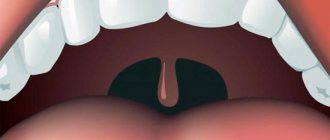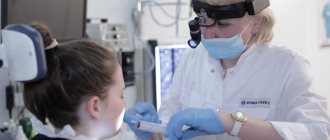Prices for services You can look at the price list or check by calling the phone number listed on the website.
The article was checked by an otorhinolaryngologist, Ph.D. Dubtsova E.A. , is for general informational purposes only and does not replace specialist advice. For recommendations on diagnosis and treatment, consultation with a doctor is necessary.
Throat diseases unite a whole group of diseases localized in the pharynx, larynx, tonsils, soft palate and palatine arches.
- At the Yauza Clinical Hospital, the diagnosis and treatment of all these diseases is carried out by specialists from the otolaryngology department - experienced doctors of the highest qualification category.
- To make an accurate diagnosis, after collecting an anamnesis and a medical examination, the necessary laboratory tests are carried out (general blood and urine tests, virological or bacteriological examination of a smear, etc.).
- The capabilities of our hospital allow us to carry out all studies in the shortest possible time and begin treatment immediately.
- 1st place in the structure of ENT diseases is occupied by diseases of the pharynx (primarily chronic pharyngitis and tonsillitis), 4th place by pathology of the larynx
- With a general weakening of the body and the absence of proper treatment, diseases can become chronic, worsening a person’s quality of life.
- Diseases of the ENT organs can lead to various complications. Considering this, it is difficult to overestimate the importance of timely contact with specialists
Sign up for a consultation
Throat diseases are a broad group of various pathological conditions, combining both acute and chronic throat diseases. Based on their origin, they are usually divided into infectious and non-infectious. Most ENT diseases of the throat are caused by viruses and bacteria that enter the mucous membrane from the outside. The wide prevalence of this pathology is associated with the structural features of the throat, which is the body’s first line of defense and always takes the brunt of infection.
The most common throat diseases:
- adenoids;
- pharyngitis;
- tumors of the larynx and oropharynx;
- laryngitis;
- peritonsillar abscess;
- tonsillitis;
- snore;
Most diseases are characterized by an acute onset with a significant deterioration in well-being. The main danger is that, if left untreated, the disease can become chronic and can also provoke the development of various complications - cardiovascular pathology, diseases of the paranasal sinuses, lungs, joints, and kidneys.
It is not customary to pay much attention to throat diseases. Many people try to treat them at home. This leads to the development of chronic forms of throat diseases. Do not self-medicate. Make an appointment with a doctor, get professional help and adequate therapy.
Symptoms of throat diseases
Most throat diseases have pronounced symptoms. Moreover, the clinical picture for each disease is individual. Among the common and most basic symptoms it is worth highlighting:
- sore throat that gets worse when swallowing;
- sore throat, dry throat;
- cough;
- hoarseness of voice;
- temperature increase;
- enlargement of the submandibular and cervical lymph nodes;
- weakness and general malaise;
- headache;
- bad breath.
The combination of several of these symptoms at once is a reason to immediately consult a doctor. If symptoms increase and health deteriorates, prompt medical care is necessary.
Some throat diseases can cause rapid swelling of the larynx. As a result, without medical assistance, the patient can quickly die from suffocation. If you experience pain, immediately make an appointment with a doctor. This will help quickly and effectively eliminate the disease.
Treatment
Pre-hospital assistance
Patients with signs of acute infections and inflammatory diseases of the ENT organs should refrain from consuming irritating mucous membranes, too cold and hot foods and drinks. It is recommended to take large amounts of warm liquid, gargle, and use topical medications. If signs of an allergy appear, you should immediately take an antiallergic drug.
Conservative therapy
Treatment of infections, inflammatory and allergic pathologies is carried out using the following methods:
- Local remedies
. Patients are prescribed antiseptic, anti-inflammatory, analgesic drugs that eliminate pain, swelling, and the sensation of a foreign body in the throat. - Antibiotics
. Required for bacterial diseases, not prescribed for viral infections. Until the results of microbiological analysis are obtained, a broad-spectrum antibiotic is used; subsequently, the drug is replaced taking into account the sensitivity of the pathogen. - Antiallergic drugs
. Allergy sufferers are prescribed antihistamines and mast cell membrane stabilizers. - Physiotherapeutic methods
. Drug therapy is supplemented with UHF, inhalations, ultraviolet irradiation, medicinal electrophoresis, and other procedures.
With a rapid increase in swelling of the throat and larynx with the development of asphyxia, emergency tracheal intubation is necessary. Patients with GERD are prescribed a special diet, antacids, proton pump inhibitors, and H2-histamine blockers. For patients with esophageal dyskinesia, fractional meals, nitrates, anticholinergics, and calcium channel blockers are recommended. For hyperthyroidism, thyreostatics are effective. For pharyngeal neurosis, combined techniques are used, including psychotherapy and pharmacotherapy.
Causes of disease development
Acute and chronic throat diseases can occur for various reasons, among the most common are:
- microorganisms (bacteria, viruses, fungi);
- gastroesophageal reflux disease (GERD);
- allergens;
- adverse environmental impacts;
- voice overstrain;
- injuries;
- hypothermia;
- general decrease in immunity;
- smoking.
A combination of several reasons is possible. Their identification and elimination is an integral part of treatment.
Causes of an unpleasant lump in the throat
- Overwork.
- Severe or long-term stress. Nervous tension.
- Neuroses and neurotic reactions.
- Depression.
- Anxiety disorder (phobias, panic attacks, generalized anxiety disorder, etc.)
- Psychosomatic diseases.
- Schizotypal disorder, schizophrenia.
- Consequences of organic damage to the nervous system after trauma. infections, strokes, heart attacks, etc.
- Diseases of internal organs (hyperthyroidism, thyroiditis, tonsillitis, spinal osteochondrosis, hiatal hernia, obesity or cachexia).
- Allergic reactions.
- Poisoning.
The most common throat diseases
Among the most common diseases of the ENT organs in this area are pharyngitis, laryngitis and tonsillitis.
Pharyngitis
Pharyngitis is an infection of the mucous membrane of the pharynx and lymph nodes. As a rule, pharyngitis occurs against the background of an acute inflammatory disease of the upper respiratory tract. More often, pharyngitis is caused by viral-bacterial flora or fungal infection; other causes include injuries and allergic reactions. With prolonged inflammation of the pharyngeal mucosa, the disease can become chronic. Frequent colds, pathology of the gastrointestinal tract, smoking, drinking alcohol, exposure to chemicals and living in unfavorable environmental conditions can contribute to this. Exacerbation of chronic pharyngitis can be facilitated by other infectious diseases, decreased immunity, hypothermia, stress, and increased physical activity.
The main symptom of pharyngitis is pain when swallowing. The disease may also be accompanied by dryness, burning, itching, general weakness and headaches. Pharyngitis is dangerous because the infection from the pharynx can move to the middle ear and cause deterioration and even hearing loss, or go down to the larynx and cause laryngitis and tracheitis.
Laryngitis
Laryngitis is an inflammatory process of the mucous membrane of the larynx. It can occur either independently or against the background of other inflammations of the nasopharynx. There are catarrhal and phlegmonous forms. The first is characterized by the spread of inflammation only to the mucous membrane of the larynx, the second - to the submucosal layer, ligaments and muscle tissue. Laryngitis can be triggered by hypothermia, contact with people with ARVI, inhalation of irritants, smoking (including hookahs and electronic cigarettes - steam generators).
A distinctive symptom of laryngitis, in addition to changes in voice, is a “barking” cough that irritates the throat. Just like other similar throat diseases, hoarseness is a characteristic symptom here; pain when swallowing, difficulty breathing, and inflammation of the lymph nodes may also be present. Among the most serious complications of laryngitis are infiltration of the epiglottis, abscess, damage to the vocal cords, up to complete loss of voice.
Angina
Sore throat is an acute infectious disease characterized by damage to the tonsils, which is caused by viruses, bacteria or fungi. In this case, pathogens can either enter the body from the outside or already be in the body and become activated when immunity decreases. A sore throat begins acutely with a sharp deterioration in well-being and an increase in body temperature to 38-39° C. It is important not to confuse this with a common cold. A sore throat is characterized by severe sore throat, swollen lymph nodes and aching joints. When examining the patient, pustules are observed on the tonsils.
If you suspect a sore throat, you should immediately consult a doctor, because improper treatment is fraught with the development of complications in the form of abscess, otitis, meningitis, sepsis and many other life-threatening conditions.
How to treat diseases of the throat and larynx
The most common ENT infections include pharyngitis, laryngitis, and tonsillitis. For a quick recovery and to prevent complications, surgical treatment is required. In the absence of timely treatment, the disease becomes chronic without symptoms.
ENT infections cause complications such as otitis media, hearing loss, abscess, cardiac dysfunction, sepsis, fever, and complete loss of voice.
Diagnosis of diseases is carried out by an ENT doctor. To determine the type of pathology, an initial examination and interview with the patient is usually sufficient. If necessary, the doctor additionally prescribes a blood test, mucosal smear or x-ray. The type of therapy is determined based on the diagnostic results, depending on the type of pathology, the severity of the disease and the general condition of the patient.
- Pharyngitis. The disease is treated with topical medications. It is necessary to gargle, throat sprays, and lozenges to eliminate soreness. It is necessary to exclude spicy, sour, hot and cold foods from the diet so as not to further irritate the inflamed mucous membrane.
- Laryngitis. During treatment, you must remain silent to allow your vocal cords to rest. To relieve laryngeal edema, moisturizing inhalations are recommended.
- Angina. The disease is caused by bacteria, so treatment is carried out using antibiotic therapy. Before taking medications, you should consult a doctor. Medicines have many contraindications and side effects. During illness, it is recommended to adhere to bed rest.
When treating any type of ENT infection, you need to drink plenty of warm fluids, maintain hygiene standards, and stop smoking and drinking alcohol. To prevent diseases, regular physical activity and walks in the fresh air are recommended. During periods of exacerbation of seasonal diseases, irrigation with a saline solution is necessary, which washes out bacteria and viruses from the mucous membranes.
Who to contact if you have a lump in your throat
The feeling of a lump in the throat is treated by a psychotherapist or psychiatrist. During the consultation, the doctor will assess the condition and determine the amount of assistance needed.
Help can be obtained in any clinic where there is a license to provide assistance in psychotherapy, psychiatry and neurology and where a psychiatrist or psychotherapist conducts an appointment.
ROSA Clinic
is a specialized and licensed clinic that provides assistance for all types of disorders accompanied by a feeling of a lump in the throat.
Our specialists
are ready to come to your home for consultation; you can also see a doctor in our clinic.
Treatment is most often carried out at home. If necessary, it is possible to be hospitalized in our own hospital, equipped with modern diagnostic equipment and where it is possible to carry out active treatment.
Burning mouth syndrome
Probably every gastroenterologist in his practice has encountered a patient with complaints of pain or burning of the tongue. Turning to this specialist in the first place is probably due to the following logical chain: the tongue is in the oral cavity, where the digestion process begins, which means that if a problem arises, you should visit a gastroenterologist. Old publications also come to the aid of patients and doctors of other specialties, in which chronic diseases of the digestive organs were considered as the causes of burning tongue.
But is it really that simple? Is pain and burning of the tongue a separate disease and who should treat it?
A little history and terminology.
Pain/burning in the tongue has many synonyms: glossalgia, glossodynia, stomatodynia, glossopyrosis, oral paresthesia, neurogenic glossitis, tongue neurosis, glossalgic syndrome. This condition is traditionally part of the so-called burning mouth syndrome or “burnt mouth syndrome,” in which pain/burning sensations are localized in various areas: tongue, upper palate, gums, lower lip, pharynx.
Burnt mouth syndrome (SMS) was first described back in 1880; in the 20th century, the term glossodynia, i.e., appeared. pain in the tongue, since unpleasant symptoms from the tongue were most common. This syndrome was first identified as a separate disease in 2004.
Almost all existing review articles and recommendations consider glossodynia within the framework of the SOP. General recommendations for the diagnosis and treatment of ROP may be applicable to the special case of glossodynia.
Definition
The International Association for the Study of Pain has designated glossodynia and oral burning as chronic pain, specifically “burning pain of the tongue or other mucous membranes of the mouth.”
Later, a detailed definition was given for ORS: “a burning sensation or sensation of altered sensitivity in the oral cavity, repeated daily for more than 2 hours a day for more than 3 months, without obvious causative lesions on clinical examination and examination.”
Epidemiology
Data on the prevalence of ROP and tongue pain/burning separately still vary from study to study. The average incidence of all cases of oral burning (including but not limited to tongue burning) is 0.1-3.7% of the population. Women suffer from this syndrome 2.5-7 times more often than men, especially often over the age of 60 and after menopause.
Common causes of pain and burning in the mouth.
There are two groups of reasons why patients notice a burning sensation in the mouth:
1) Primary (idiopathic), when there are no diseases of the oral cavity and other organs and systems, this will be the true SOR.
2) Secondary, caused by local (localized in the oral cavity) and systemic causes (autoimmune diseases, deficiency conditions, etc.)
Causes of secondary burning sensation in the mouth/burning tongue.
Possible causes of secondary burning sensation in the oral cavity are diverse and, oddly enough, are rarely associated with pathology of the digestive organs. A review published in 2022 on this problem identified the following conditions and diseases responsible for the occurrence of burning sensation in the mouth:
Local factors:
A. Diseases, conditions and damage to the oral cavity:
- fungal infection (eg candidiasis)
- lichen planus
- pemphigoid
- pemphigus
B. Trauma
1) Mechanical
2) Chemical
A. From the patient's side:
- toothpastes with abrasives
- use of mouth rinses with ethyl alcohol
- medications such as aspirin (applied to the sore tooth); over-the-counter medications containing phenols, peroxide, sulfuric acid
- vitamin C (citrus fruits)
- sour drinks
- lozenges and cough suppressants with high menthol content
b. From the dentist:
- Irrigation of the oral cavity with solutions containing methyl methacrylate, formaldehyde, formocresol, sodium hypochloride
- acrylic resin
- eugenol
3) Thermal: spicy or hot food or drink
C. Parafunctional habits
- Tongue sticking out, cheek biting, excessive tongue brushing
- mouth breathing
D. Xerostomia or impaired quality/quantity of saliva
- consequences of radiation or chemotherapy, Sjogren's syndrome, pathology of the salivary glands
- side effects of medications (antihistamines, antidepressants, diuretics, steroid hormones, non-steroidal anti-inflammatory drugs, amphetamines)
- smoking
E. Allergic reaction/contact hypersensitivity
- products, additives, flavors
- colorings and flavors from oral care products
- dental materials (nickel sulfate, cobalt, zinc)
System factors
A. Deficiency conditions: decreased levels of iron, zinc, folic acid, vitamins B1, B2, B6, B12
B. Endocrine pathology
- diabetes
- hypothyroidism
- hormonal disorders (changes in cortisol/sex hormone levels)
C. Autoimmune diseases
- Sjögren's syndrome
- lichenoid reactions
- systemic lupus erythematosus
D. Other diseases
- gastroesophageal reflux disease
- celiac disease
- multiple sclerosis
- Parkinson's disease
- Fabry disease
E. Medicines
- angiotensin-converting factor inhibitors
- antiretroviral therapy
F. Peripheral and central neuropathies
- diabetic polyneuropathy, neuropathy due to renal failure, neuropathy due to systemic connective tissue diseases, neuropathy due to HIV infection, postherpetic neuropathy, neuropathy due to chemotherapy
As can be seen from this huge list, most cases of burning of the tongue and in the oral cavity in general are caused by a dental problem/pathology, neurological, endocrine and autoimmune diseases. Gastroenterological causes (for example, gastroesophageal reflux disease) are rather the exception to the rule.
Primary burning sensation in the oral cavity (BOR) and its causes.
If there are no indications of secondary causes of burning in the oral cavity, most likely there is a true SOR. This is an independent disease, the cause of which is still unclear. In its development, the role of psychological factors and mental disorders, changes in the nerve endings and conductive nerve fibers of the oral cavity, as well as the central nervous system is assumed.
Clinical manifestations of ROP.
Symptoms that may bother patients with ROP are:
1) Pain and/or burning in the mouth of varying intensity. Some patients describe these sensations as tingling or irritation, as well as impaired sensitivity. The pain often occurs spontaneously, is often symmetrical and does not necessarily affect only one area. In the case of glossodynia, pain/burning is most often localized in the anterior 2/3 of the tongue, on its back, and lateral surfaces. The pain is minimal in the morning immediately after waking up, increasing in intensity throughout the day. Eating spicy, hot foods and drinks, as well as stress and fatigue increase the pain/burning sensation.
2) More than 70% of patients, in addition to pain/burning, note changes in taste, a decrease in its intensity, as well as the appearance of a foreign taste (bitter, metallic, or a combination of both). Most often, the sensation of sweet and salty tastes is reduced, and sour tastes are perceived more intensely.
3) Dry mouth (xerostomia) is noted by 46-67% of patients with SOP, while according to research data, an objective decrease in the amount of saliva is not observed in them.
4) Association with burning/pain from other mucous membranes has also been described in patients suffering from ROP. Most often this is a burning sensation in the rectum and genital tract. An alternative may be a feeling of dry mucous membranes (eyes, genital tract in women)
5) Night sleep disturbances are common (in 80% of cases) in people with SRS
6) Anxiety and depression are frequent companions of SOR and glossodynia separately. A meta-analysis of clinical studies showed that anxiety conditions increase the risk of developing RAS by 2.6 times, and depression by 3.2 times. Cancerophobia, social phobia, neuroticism, etc. are also often noted.
7) ODS is characterized by an association with other diseases that manifest as chronic pain: fibromyalgia, chronic back pain, chronic pelvic pain, irritable bowel syndrome, etc.
Treatment of SOR.
1) Patient information and support
Many patients with chronic oral burning and pain do not understand why their symptoms persist for so long. An important task of the doctor is to explain to patients with SRS the possible mechanisms of the formation of unpleasant sensations. Patients should be reassured that their symptoms are not imaginary or related to any form of cancer. This support will reduce anxiety, depression, fear and frustration, especially in individuals who have had previous unsuccessful treatment experiences.
2) Local therapy
Local use of clonazepam in the form of mouth rinses showed good results in reducing the severity of pain/burning in the mouth. There is encouraging evidence for the topical use of capsaicin (a chili pepper alkaloid) in low concentrations.
3) Systemic therapy
Tricyclic antidepressants, antidepressants from the group of serotonin and serotonin/norepinephrine reuptake inhibitors, clonazepam, and antiepileptic drugs (pregabalin and gabapentin) are actively used as drugs for the treatment of ORA. The use of alpha-thioctic acid showed little effectiveness.
4) Non-drug psychotherapy
Given the frequent association of ODS with anxiety disorders, phobias and depression, non-pharmacological psychotherapy is an integral part of the treatment of this problem. Cognitive behavioral therapy, individual and group psychotherapy should be considered as methods of choice.
5) Physiotherapy and alternative treatments
Low-level laser therapy and acupuncture have been studied as methods for reducing pain. These methods were effective in some people with cerebral obstruction, but are not widely used.
Conclusion.
Identifying the causes of pain/burning in the oral cavity is a challenge for doctors of different specialties, but their friendly work allows us to solve the problem and improve the quality of life of patients.
For what changes in the throat should you call an ambulance?
Some throat diseases pose a threat to the lives of patients, especially in childhood. Calling an ambulance is necessary in the following cases:
- When examining the larynx, a narrowing of the lumen is observed. It becomes difficult for a person to breathe. This condition may indicate laryngeal stenosis, which can be fatal, especially for children.
- The throat is strewn with ulcers, ulcers, rashes, and the body temperature is higher than normal.
- Vessels bleed on the back wall of the larynx. The patient has signs of intoxication, vomiting, fever.
Symptoms of stomatitis in adults:
- The disease is accompanied by general malaise, but a person’s temperature rarely rises above 37.5 degrees.
- An adult's throat, just like a child's, with stomatitis becomes red, swollen, and painful ulcers appear on the surface of the mucous membrane.
- Lymph nodes do not always enlarge.
An adult who experiences stomatitis ulcers in the mouth should consult a physician or dentist. Only a doctor will be able to correctly diagnose the disease and prescribe effective treatment for stomatitis formations in the patient’s throat.











